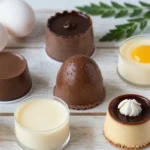We’ve fallen head over heels for matcha’s vibrant green hue and distinctive earthy-sweet flavor that transforms ordinary desserts into Instagram-worthy masterpieces. This finely ground Japanese green tea powder isn’t just a trendy ingredient—it’s packed with antioxidants and delivers a gentle caffeine boost that won’t leave you jittery like coffee often does.
From creamy matcha lattes that rival your favorite café’s offerings to decadent white chocolate matcha cookies that melt in your mouth, we’ve curated the most irresistible matcha recipes that’ll satisfy every craving. Whether you’re a matcha newbie curious about this emerald powder or a seasoned enthusiast looking to expand your repertoire, these recipes strike the perfect balance between authentic Japanese flavors and modern creativity.
Get ready to discover why matcha has captured hearts worldwide—and prepare to become completely obsessed with its unique taste that’s both grounding and energizing at once.
What Is Matcha and Why Use It in Recipes
Matcha is finely ground powder made from specially grown and processed green tea leaves called tencha. We cultivate these tea plants in shade for several weeks before harvest which boosts chlorophyll levels and creates that signature vibrant green color. The entire leaf gets consumed when we use matcha unlike regular tea where we steep and discard the leaves.
Traditional Japanese tea ceremonies have featured matcha for over 800 years. Stone grinding mills transform the dried tea leaves into the ultra-fine powder we recognize today. This ancient process preserves the delicate flavors and nutrients that make matcha so special in both beverages and baking.
Quality grades of matcha vary significantly based on the tea plant parts used and processing methods. Ceremonial grade matcha offers the smoothest flavor and brightest color for drinking. Culinary grade matcha works perfectly for recipes since it maintains its distinctive taste even when mixed with other ingredients.
The unique umami flavor profile sets matcha apart from other baking ingredients. Sweet notes balance the subtle bitterness while earthy undertones add complexity to desserts. We find this flavor enhances chocolate desserts and pairs beautifully with vanilla and white chocolate.
Matcha provides natural coloring that eliminates the need for artificial food dyes. The chlorophyll creates stunning green hues that range from pale mint to deep forest depending on the amount used. This natural pigment stays stable during baking and maintains its beauty in finished dishes.
Antioxidant levels in matcha exceed those found in most other superfoods. Catechins like EGCG offer powerful health benefits while L-theanine provides calm energy without the jitters associated with coffee. These compounds remain active even after baking which means our matcha treats deliver wellness benefits alongside great taste.
Caffeine content in matcha provides gentle sustained energy release. One teaspoon contains approximately 35mg of caffeine compared to 95mg in a cup of coffee. This moderate amount enhances focus and alertness without causing crashes making matcha desserts perfect for afternoon treats.
Versatility makes matcha an ideal ingredient for both traditional and modern recipes. We can incorporate it into everything from classic Japanese sweets to contemporary fusion desserts. The powder dissolves easily into batters and creams while maintaining its nutritional properties throughout the cooking process.
Essential Matcha Baking Tips
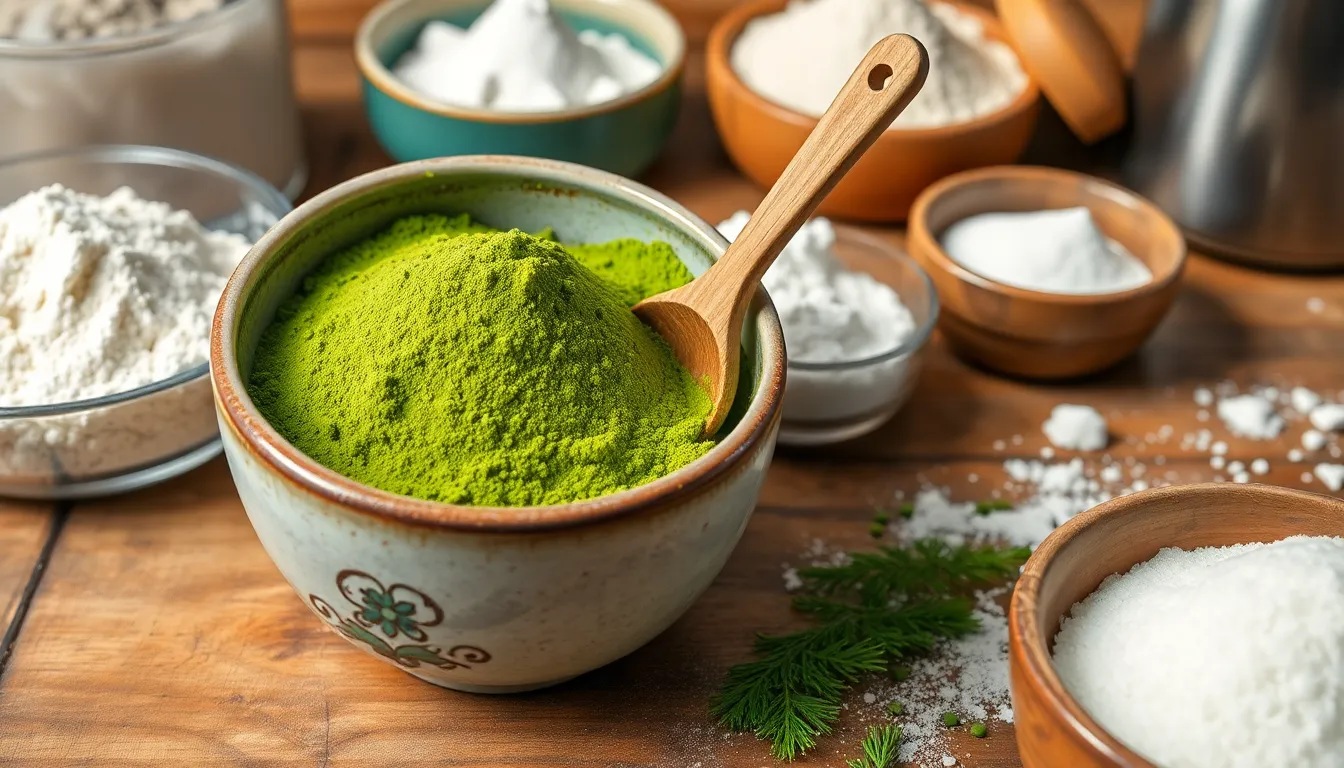
Mastering matcha baking requires understanding key techniques that ensure optimal flavor and color in your desserts. We’ll guide you through the essential tips that transform ordinary baking into extraordinary matcha creations.
Choosing the Right Matcha Powder
High-quality matcha powder forms the foundation of successful matcha baking. We recommend selecting matcha that displays a vibrant green color and possesses a fine, silky texture for the strongest and richest flavor profile. Culinary grade matcha works perfectly for baking projects while remaining more budget-friendly than ceremonial varieties. The powder should feel smooth between your fingers without any grittiness or coarse particles.
Fresh matcha exhibits a bright emerald hue rather than a dull or yellowish tint. We suggest purchasing from reputable suppliers who store their matcha properly and provide harvest dates. Premium matcha delivers more intense flavor with less powder needed, making it cost-effective even though higher upfront costs.
Balancing Matcha’s Bitter Notes
Matcha’s natural bitterness requires careful balancing with complementary sweet ingredients. We achieve harmony by incorporating sugar, honey, or other sweeteners that counteract matcha’s astringent qualities without masking its distinctive flavor. Start with smaller amounts of matcha powder and gradually increase to find your preferred intensity level.
White chocolate pairs exceptionally well with matcha by mellowing its sharpness while improving the green tea notes. We often combine matcha with vanilla or almond extracts to create complex flavor layers. Dairy ingredients like cream, butter, and milk also help soften matcha’s edge while adding richness to baked goods.
Testing your batter or dough before baking allows you to adjust sweetness levels accordingly. We recommend tasting and tweaking until you achieve the perfect balance for your palate.
Storage and Freshness Guidelines
Proper storage preserves matcha’s vibrant color and prevents flavor deterioration. We store our matcha powder in airtight containers away from light, heat, and moisture to maintain peak quality. Dark pantry locations or refrigerator storage work best for long-term preservation.
| Storage Factor | Recommendation |
|---|---|
| Container Type | Airtight, opaque |
| Temperature | Cool, consistent |
| Light Exposure | Dark storage area |
| Shelf Life | 6 months after opening |
Matcha loses potency quickly once exposed to air and light. We transfer opened packages to sealed containers immediately and use within six months for optimal results. Refrigerated matcha should return to room temperature before use to prevent condensation issues.
Fresh matcha maintains its characteristic bright green color and aromatic fragrance. We discard any matcha that appears brown or lacks its distinctive grassy scent, as these indicate quality decline that will negatively impact your baking results.
Easy Matcha Drink Recipes
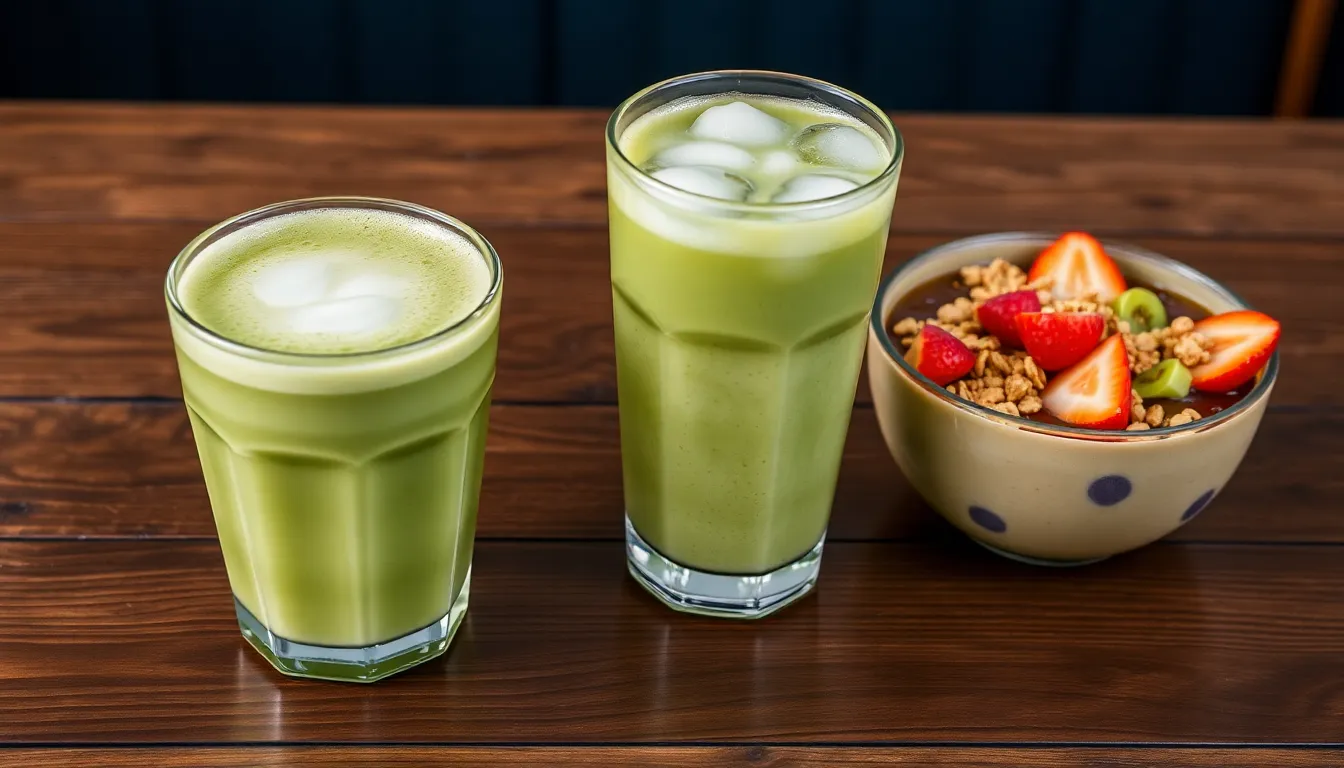
We love transforming the earthy sweetness of matcha into refreshing beverages that satisfy any craving. These simple drink recipes showcase matcha’s versatility beyond traditional tea ceremonies.
Classic Matcha Latte
Our classic matcha latte combines the rich umami flavors of ceremonial grade matcha with creamy coconut milk for a perfectly balanced drink. We start by sifting ½ to 1 teaspoon of matcha powder to eliminate any lumps that could affect the smooth texture.
Ingredients:
- ½ to 1 teaspoon matcha powder
- ¼ cup hot water
- ¼ cup coconut milk, warmed
- Maple syrup, honey, or stevia (optional)
We whisk the sifted matcha powder with hot water in a mug until the mixture becomes frothy and well combined. The whisking creates that signature foam layer that elevates the drinking experience. Next, we add the warmed coconut milk and whisk until the ingredients blend seamlessly together. Sweetener can be added according to personal preference for those who enjoy a sweeter profile.
Iced Matcha Bubble Tea
We transform the traditional bubble tea experience with our matcha version that combines the powder’s vibrant green color with chewy tapioca pearls. This refreshing drink offers both visual appeal and textural contrast in every sip.
Ingredients:
- 1 teaspoon matcha powder
- 1 cup cold milk
- 1 tablespoon honey (optional)
- Tapioca pearls
- Ice cubes
We begin by whisking the matcha powder with a small amount of hot water to create a smooth paste that eliminates any grittiness. This paste method ensures the matcha dissolves completely without clumping. We then mix the matcha paste with cold milk and honey if desired for added sweetness. The prepared tapioca pearls are added to the bottom of the glass before pouring the matcha mixture over ice cubes.
Matcha Smoothie Bowl
Our matcha smoothie bowl creates a nutritious and Instagram worthy breakfast that showcases matcha’s natural food coloring properties. We blend frozen ingredients to achieve that thick, creamy consistency perfect for holding toppings.
Ingredients:
- 1 teaspoon matcha powder
- 1 cup frozen yogurt or banana
- ½ cup milk
- Granola, fresh fruit, and coconut flakes for toppings
We blend the matcha powder with frozen yogurt or banana and milk until the mixture reaches a smooth, thick consistency. The frozen base creates that perfect smoothie bowl texture that supports various toppings without becoming too liquid. We finish by arranging granola, fresh fruit, and coconut flakes on top to add both visual appeal and nutritional value to this antioxidant rich breakfast option.
No-Bake Matcha Desserts
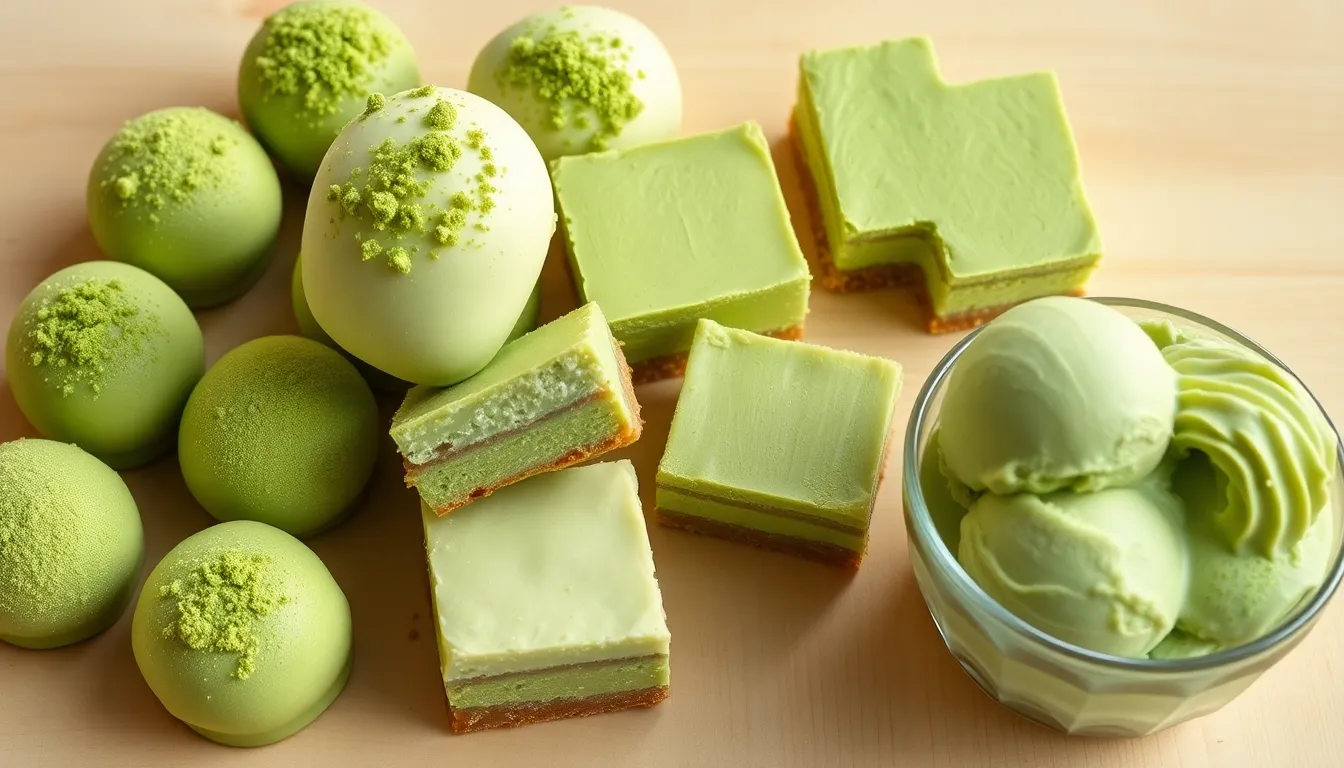
When we crave matcha treats without turning on the oven, these no-bake desserts deliver incredible flavor with minimal effort. These recipes showcase matcha’s versatility while keeping our kitchens cool.
Matcha White Chocolate Truffles
We transform simple ingredients into elegant bite-sized treats with these luxurious matcha truffles. The combination of earthy matcha and sweet white chocolate creates a perfect flavor balance.
Ingredients:
- 8 oz white chocolate, finely chopped
- 1/3 cup heavy cream
- 2 tablespoons high-quality matcha powder
- 1 teaspoon vanilla extract
- Additional matcha powder for dusting
Instructions:
Place chopped white chocolate in a heatproof bowl and set aside. Heat heavy cream in a small saucepan until it begins to simmer around the edges. Pour hot cream over chocolate and let sit for 2 minutes without stirring.
Whisk the mixture gently from the center outward until smooth and glossy. Sift matcha powder directly into the chocolate mixture to prevent lumps. Add vanilla extract and whisk until completely incorporated.
Cover the bowl with plastic wrap and refrigerate for 2 hours until firm enough to shape. Scoop mixture using a small spoon or melon baller and roll into 1-inch balls with your hands. Dust each truffle with additional matcha powder and store in the refrigerator for up to one week.
Matcha Cheesecake Bars
Our no-bake matcha cheesecake bars offer all the creamy richness of traditional cheesecake with an irresistible matcha twist. These bars slice beautifully and require no special equipment.
Ingredients:
- 2 cups Oreo cookie crumbs
- 1/3 cup unsalted butter, melted
- 16 oz full-fat cream cheese, softened
- 1/2 cup powdered sugar
- 3 tablespoons matcha powder
- 1 teaspoon vanilla extract
- 1 cup heavy cream
Instructions:
Line an 8×8 inch pan with parchment paper leaving overhang for easy removal. Mix cookie crumbs with melted butter until evenly moistened. Press mixture firmly into the bottom of prepared pan and refrigerate while preparing filling.
Beat cream cheese in a large bowl until smooth and fluffy. Sift powdered sugar and matcha powder together then gradually beat into cream cheese. Add vanilla extract and mix until combined.
Whip heavy cream in a separate bowl until soft peaks form. Gently fold whipped cream into matcha mixture in three additions until no streaks remain. Spread filling evenly over chilled crust and smooth the top with an offset spatula.
Refrigerate bars for at least 4 hours or overnight until completely set. Lift from pan using parchment overhang and cut into squares with a sharp knife wiped clean between cuts.
Matcha Ice Cream
We create restaurant-quality matcha ice cream at home without an ice cream maker using this simple no-churn method. The result is incredibly smooth and intensely flavored frozen dessert.
Ingredients:
- 2 cups heavy cream, chilled
- 1 can (14 oz) sweetened condensed milk
- 3 tablespoons high-quality matcha powder
- 1 teaspoon vanilla extract
- Pinch of salt
Instructions:
Sift matcha powder into a small bowl to remove any lumps. Whisk in 3 tablespoons of the sweetened condensed milk until smooth and paste-like. Gradually whisk in remaining condensed milk until completely smooth.
Whip heavy cream in a large bowl until stiff peaks form. Add vanilla extract and salt to matcha mixture then gently fold into whipped cream in three additions. Fold just until no streaks remain while being careful not to deflate the cream.
Transfer mixture to a freezer-safe container and smooth the top. Press plastic wrap directly onto surface to prevent ice crystals from forming. Freeze for at least 6 hours or overnight until completely firm.
Scoop ice cream 10 minutes after removing from freezer for easier serving. Store covered in freezer for up to one month for best quality and flavor.
Baked Matcha Treats
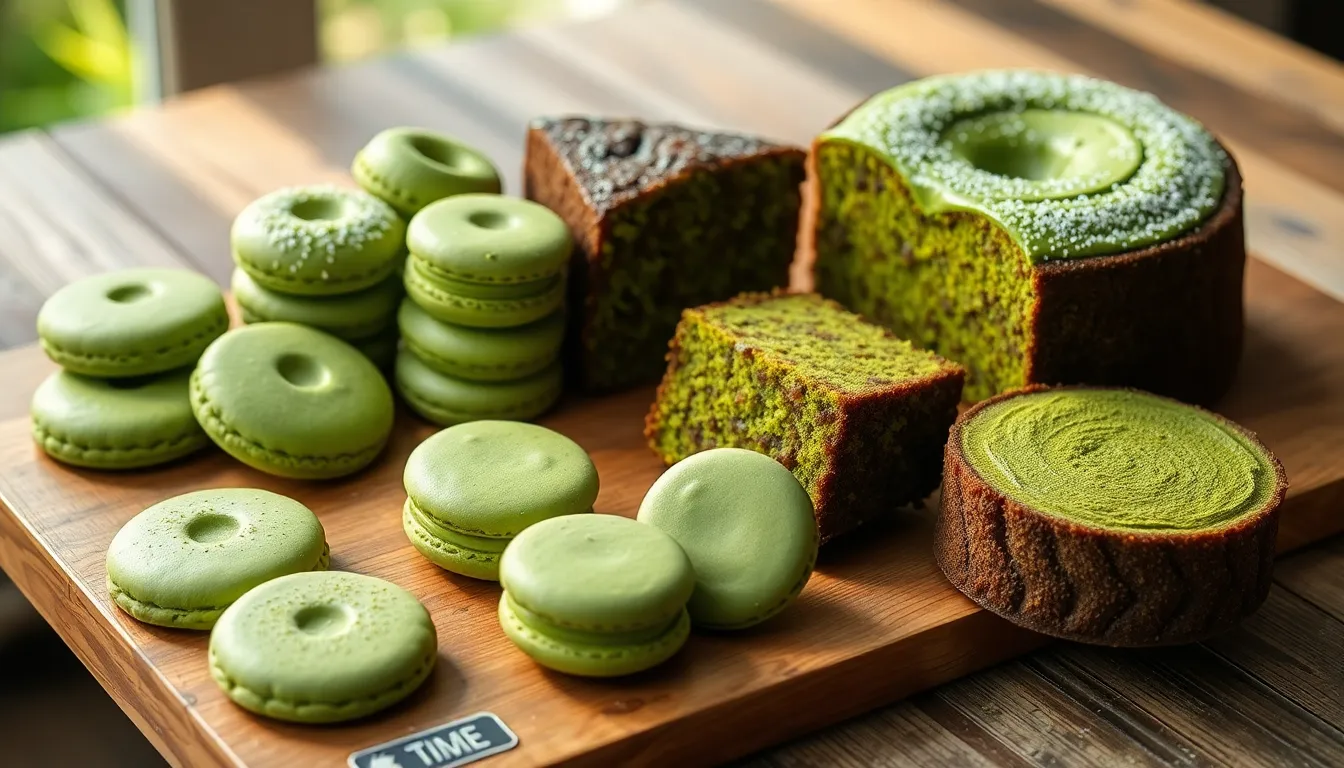
We explore the wonderful industry of matcha baking with these irresistible recipes that showcase the versatility of this beloved green tea powder. Our collection of baked treats transforms ordinary desserts into extraordinary matcha experiences.
Matcha Sugar Cookies
These delightful matcha sugar cookies offer the perfect introduction to baking with green tea powder. We love how the earthy matcha flavor balances beautifully with the sweetness of sugar.
Ingredients:
- ½ cup unsalted butter, softened
- ¾ cup granulated sugar
- 2 teaspoons matcha powder
- 1 large egg
- 1 ½ cups all-purpose flour
- ½ teaspoon baking soda
- ¼ teaspoon cream of tartar
- ¼ teaspoon kosher salt
- Extra granulated sugar for rolling
Instructions:
We start by creaming the softened butter with sugar and matcha powder until the mixture becomes smooth and vibrant green. Beat in the egg thoroughly to ensure even distribution throughout the dough.
Combine all dry ingredients in a separate bowl before gradually mixing them into the wet ingredients. Continue mixing until a cohesive dough forms without overworking the mixture.
Wrap the dough in plastic and refrigerate for at least 1 hour to firm up for easier handling. This chilling step prevents the cookies from spreading too much during baking.
Preheat your oven to 350°F while the dough chills. Scoop the chilled dough into uniform balls and roll each one in granulated sugar for a delightfully crispy exterior.
Place the sugar-coated dough balls on lined baking sheets and bake for 13-15 minutes until the edges are set but centers remain soft.
Matcha Macarons
These elegant French cookies showcase matcha’s sophisticated flavor in their delicate shells and creamy filling. We recommend using high-quality culinary grade matcha for the most vibrant color and authentic taste.
The process involves creating perfectly smooth meringue-based shells infused with matcha powder. We incorporate the matcha into the almond flour mixture to ensure even distribution throughout each macaron shell.
For the filling, we prepare a rich buttercream enhanced with matcha powder that complements the subtle sweetness of the cookie shells. The result creates an exquisite balance of textures and flavors.
These macarons require precise technique but reward bakers with stunning presentation and incredible taste. We suggest practicing the macaronage technique to achieve the perfect consistency before piping.
Matcha Pound Cake
Our matcha pound cake delivers rich, dense texture with the distinctive earthy sweetness that makes matcha so appealing. This recipe creates a beautiful green-hued loaf that’s perfect for afternoon tea or special occasions.
Ingredients:
- 1 cup unsalted butter, softened
- 1 ¾ cups granulated sugar
- 4 large eggs
- 2 cups all-purpose flour
- 2 tablespoons matcha powder
- 1 teaspoon baking powder
- ½ teaspoon salt
Instructions:
Preheat your oven to 325°F and thoroughly grease a standard loaf pan to prevent sticking. We recommend using butter or cooking spray for best results.
Cream the softened butter with sugar until the mixture becomes light and fluffy. This process incorporates air into the batter for a tender crumb.
Add eggs one at a time, beating well after each addition to maintain the emulsion. Each egg should be fully incorporated before adding the next.
Whisk together flour, matcha powder, baking powder, and salt in a separate bowl. This ensures even distribution of the matcha throughout the cake.
Gradually fold the dry ingredients into the butter mixture, mixing just until combined. Overmixing can result in a tough, dense cake.
Pour the batter into your prepared loaf pan and smooth the top with a spatula. Bake for 45-50 minutes or until a toothpick inserted in the center comes out clean.
Cool the cake in the pan for 10 minutes before turning out onto a wire rack to finish cooling completely.
Traditional Japanese Matcha Sweets
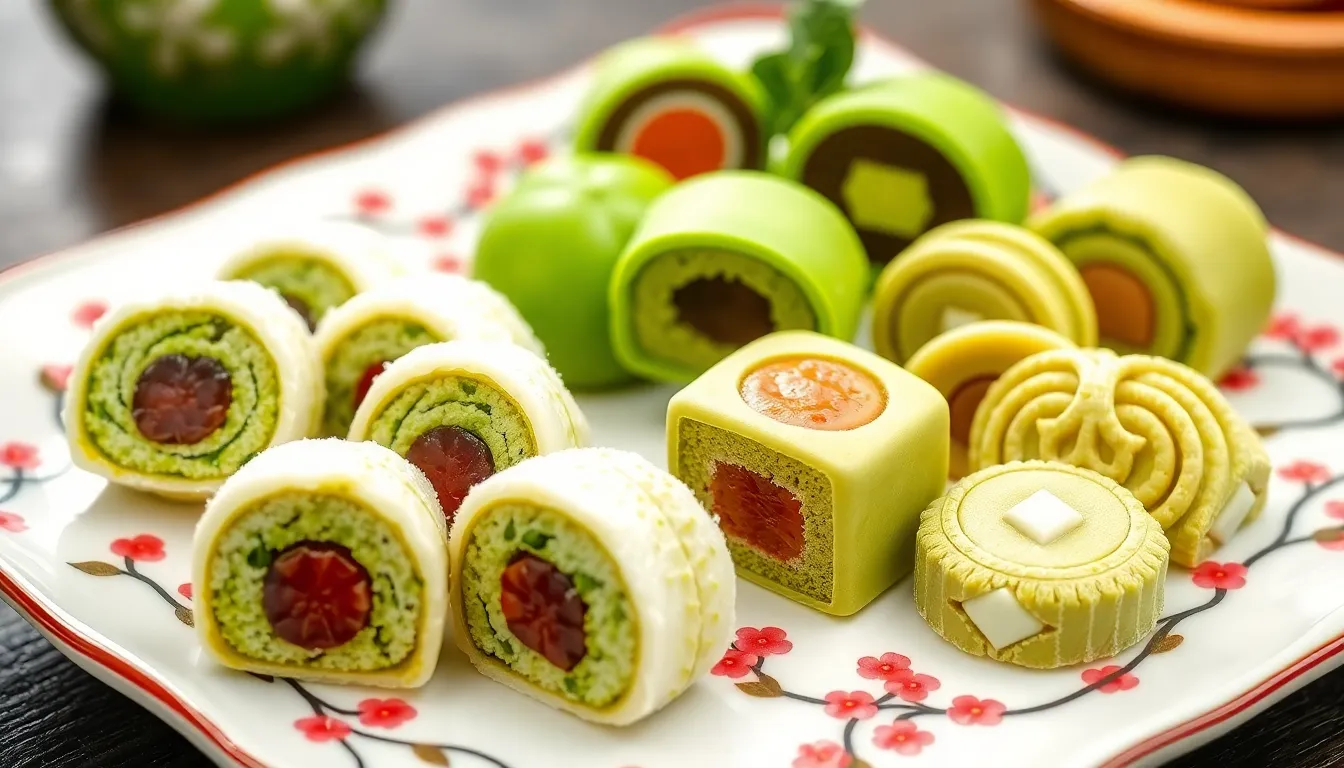
Japan’s centuries-old tradition of incorporating matcha into confections has created an elegant collection of sweets that perfectly balance the powder’s earthy complexity with delicate textures. These time-honored treats showcase matcha’s versatility beyond modern fusion desserts.
Matcha Mochi
We find matcha mochi to be one of the most beloved traditional Japanese sweets that transforms the classic glutinous rice confection into a vibrant green tea experience. The preparation involves incorporating matcha powder directly into the mochi dough or blending it into the filling for deeper flavor integration.
Sweet fillings like red bean paste create the perfect counterbalance to matcha’s natural bitterness while strawberries add fresh sweetness and beautiful color contrast. The chewy texture of mochi provides an ideal canvas for matcha’s complex flavor profile to shine through each bite.
Traditional matcha mochi achieves its signature jade green color through high-quality culinary grade matcha that maintains vibrancy even after cooking. We recommend using approximately 2-3 tablespoons of matcha powder per cup of mochi flour for optimal color and taste balance.
Matcha Dorayaki
Dorayaki represents a cherished Japanese dessert that transforms into something extraordinary when enhanced with matcha powder. We create these small pancake sandwiches by incorporating matcha directly into the batter to achieve the characteristic green tea flavor throughout each fluffy layer.
The traditional red bean paste filling provides essential sweetness that harmonizes beautifully with matcha’s earthy notes. Each dorayaki consists of two perfectly round pancakes that sandwich the sweet filling while showcasing matcha’s distinctive green hue.
Matcha dorayaki requires careful temperature control during cooking to prevent the matcha from becoming bitter while ensuring the pancakes develop their signature golden exterior. We find that medium-low heat works best for achieving tender texture while preserving matcha’s delicate flavor compounds.
Matcha Wagashi
Wagashi encompasses the entire industry of traditional Japanese sweets that are artfully crafted to complement tea ceremonies and seasonal celebrations. We appreciate how matcha wagashi takes many forms including delicate mochi shapes and elegant daifuku filled with matcha ganache.
These confections showcase incredible artistry through their intricate designs that often reflect seasonal themes like cherry blossoms or autumn leaves. Matcha wagashi can feature the green tea powder in both the outer layer and inner filling for layered flavor complexity.
The preparation of matcha wagashi requires precision and patience as each piece is carefully molded by hand to achieve perfect aesthetic balance. We find that matcha daifuku represents one of the most popular wagashi varieties with its round mochi exterior embracing sweet matcha-infused centers that deliver pure indulgence in every bite.
Savory Matcha Recipes
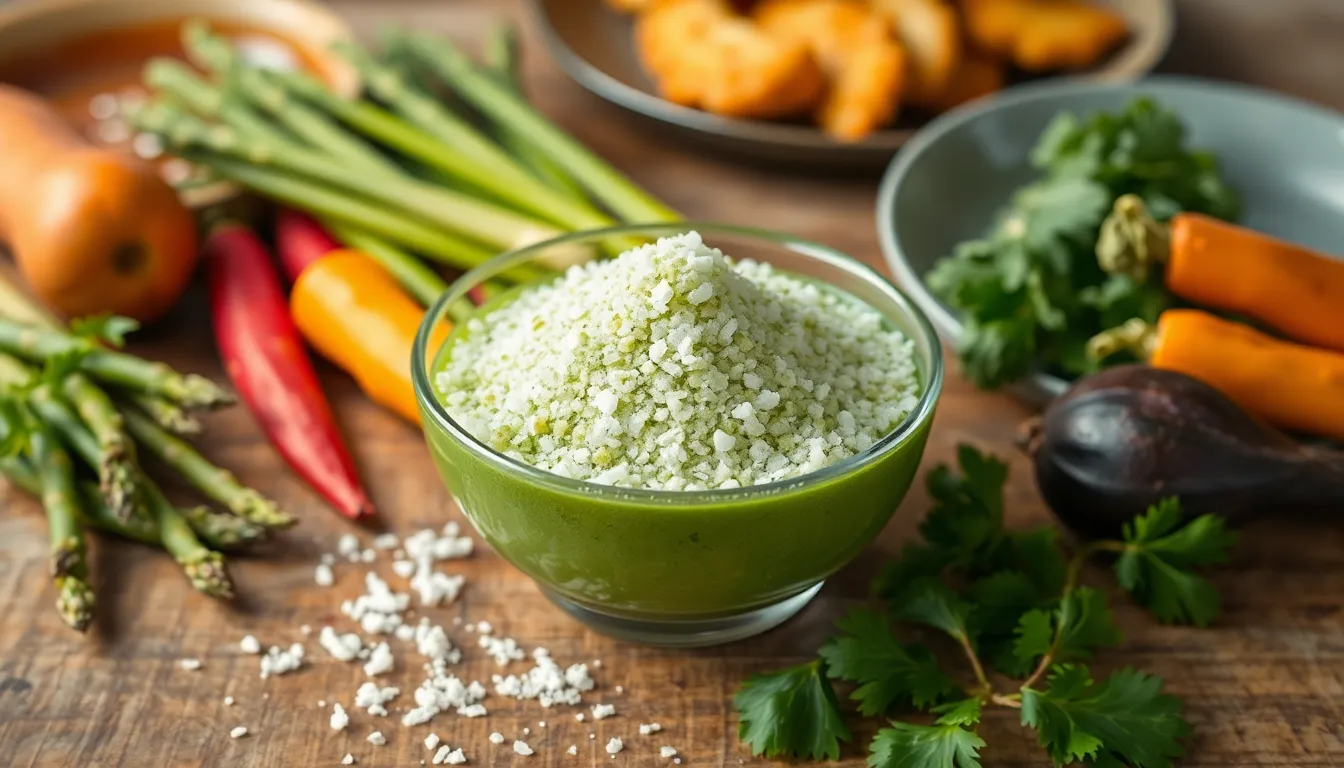
While matcha shines in sweet applications, its earthy umami notes create equally impressive savory dishes. We’re exploring three fundamental techniques that transform matcha into versatile culinary tools for improving everyday cooking.
Matcha Salt for Seasoning
We combine high-quality matcha powder with coarse sea salt to create this distinctive seasoning blend that adds depth to multiple dishes. This vibrant green mixture brings subtle umami flavors alongside the familiar saltiness we love.
Ingredients:
- 2 tablespoons coarse sea salt
- 1 teaspoon culinary grade matcha powder
Instructions:
Mix matcha powder and sea salt in a small bowl until evenly distributed and the mixture takes on a uniform green color. Store in an airtight container for up to three months. We sprinkle this seasoning over grilled fish, roasted vegetables, or tempura for an instant flavor upgrade. The combination works particularly well with simple proteins where the matcha’s earthiness can shine without competing flavors.
Matcha Noodles
Fresh noodles infused with matcha create stunning green pasta that pairs beautifully with both Asian and Western preparations. We incorporate matcha directly into the dough for consistent flavor and color throughout each strand.
Ingredients:
- 2 cups all-purpose flour
- 3 large eggs
- 2 tablespoons matcha powder
- 1 teaspoon salt
- 1 tablespoon olive oil
Instructions:
Whisk matcha powder with flour and salt in a large mixing bowl. Create a well in the center and add beaten eggs plus olive oil. We gradually incorporate the flour mixture until a smooth dough forms. Knead for 8-10 minutes until the dough becomes elastic and vibrant green. Rest the dough for 30 minutes before rolling through a pasta machine or cutting by hand. Cook fresh matcha noodles in boiling salted water for 2-3 minutes until al dente. These noodles complement light broths, sesame-based sauces, or simple butter preparations.
Matcha Tempura Batter
Traditional tempura batter enhanced with matcha powder creates a delicate coating with subtle green tea notes. We achieve the lightest possible texture while infusing each bite with earthy matcha flavor.
Ingredients:
- 1 cup ice-cold sparkling water
- 1 cup all-purpose flour
- 2 tablespoons matcha powder
- 1/2 teaspoon salt
- 1 egg yolk
Instructions:
Sift flour, matcha powder, and salt together into a chilled bowl. We whisk egg yolk lightly and combine with ice-cold sparkling water. Pour the liquid mixture into the flour mixture and stir minimally with chopsticks or a fork, leaving some lumps for the ideal tempura texture. The batter should remain slightly lumpy and very cold. Dip vegetables or seafood immediately into the batter and fry in oil heated to 340°F until golden and crispy. This matcha tempura batter works exceptionally well with spring vegetables like asparagus, sweet potato, and shishito peppers.
Equipment and Tools Needed
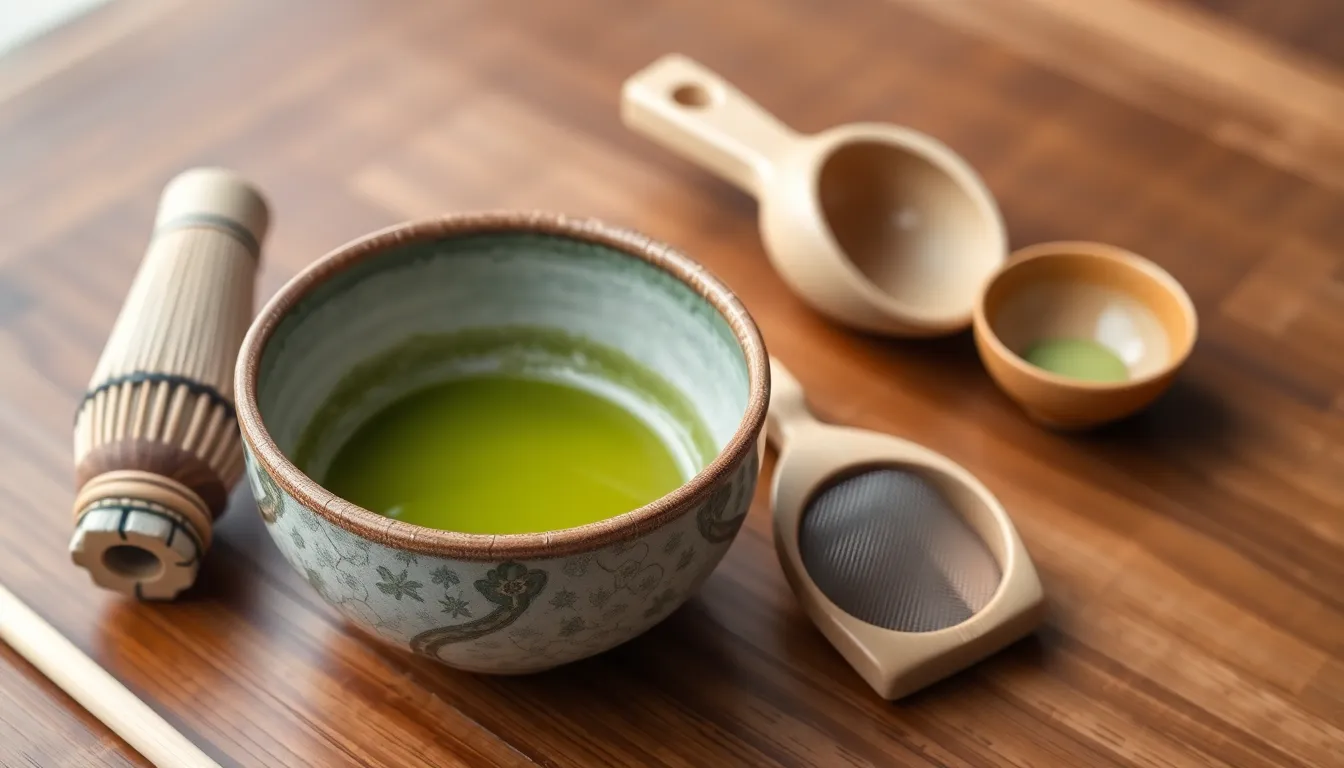
Creating exceptional matcha recipes requires the right equipment to achieve authentic flavors and textures. We recommend investing in traditional Japanese tools that have been perfected over centuries for optimal matcha preparation.
Essential Traditional Tools
Chasen (Bamboo Whisk) stands as the most crucial tool for matcha preparation. This traditional bamboo whisk features either 80 or 100 fine tines that create the smooth, frothy texture essential for quality matcha. We find that the delicate tines break up clumps and incorporate air effectively, resulting in the characteristic foam layer that enhances both flavor and presentation.
Chawan (Matcha Bowl) provides the perfect vessel for whisking matcha. These handmade clay bowls feature a cylindrical shape with a wide base that gives ample room for whisking motions. The traditional design allows for proper technique while preventing splashing during preparation.
Chashaku (Matcha Spoon) offers precise measurement for matcha powder. This bamboo scoop features a vertical design that makes scooping from containers effortless while ensuring consistent portions for each preparation.
Preparation Equipment
Matcha Sifter (Furui) eliminates clumps before whisking begins. This fine mesh strainer ensures smooth, lump-free matcha powder that whisks evenly and creates better texture in both drinks and recipes.
Electric Kettle provides temperature control for optimal water heating. We recommend models that allow precise temperature settings since matcha requires water heated to 160°F to 170°F for best results.
Equipment Performance Data
| Tool | Primary Function | Traditional Material | Key Benefit |
|---|---|---|---|
| Chasen | Whisking | Bamboo with 80-100 tines | Creates frothy texture |
| Chawan | Mixing vessel | Handmade clay | Wide base for whisking room |
| Chashaku | Measuring | Bamboo | Precise portion control |
| Furui | Sifting | Fine mesh | Eliminates clumps |
| Electric Kettle | Water heating | Various | Temperature precision |
Modern Alternatives
Electric milk frothers can substitute for bamboo whisks when traditional tools are unavailable. Regular mixing bowls work in place of chawan though they lack the optimal shape for traditional whisking techniques. Digital kitchen scales provide accurate measurements when matcha spoons are not accessible.
Investing in authentic equipment enhances your matcha experience significantly. The traditional tools create textures and flavors that modern substitutes cannot fully replicate, making them worthwhile additions to any serious matcha enthusiast’s kitchen.
Make-Ahead Instructions and Storage Tips
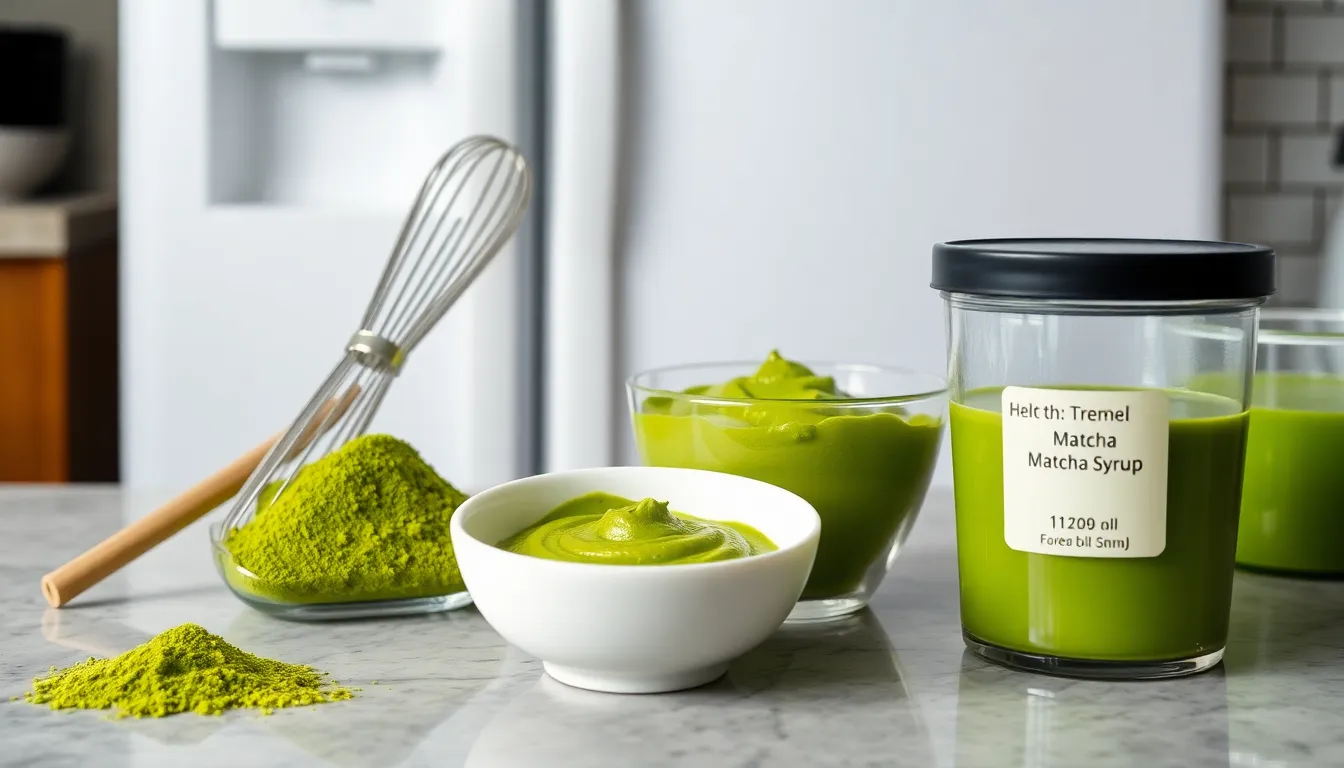
Proper planning transforms our matcha cooking experience from stressful to seamless. We can prepare several matcha components ahead of time to streamline our baking and cooking processes while maintaining optimal flavor and quality.
Preparing Matcha Components in Advance
We recommend whisking matcha powder with a small amount of hot water to create a smooth paste before incorporating it into recipes. This mixture eliminates lumps and ensures even distribution throughout our desserts and beverages. Store this prepared matcha paste in an airtight container in the refrigerator where it maintains its quality for up to 24 hours.
Matcha simple syrup offers another excellent make ahead option for our drinks and desserts. We combine equal parts sugar and water with matcha powder to create this versatile sweetener that keeps in the refrigerator for up to one week. This syrup works beautifully in lattes, cocktails, and as a glaze for cakes.
Optimal Matcha Powder Storage Methods
Temperature control plays a crucial role in preserving our matcha’s vibrant color and delicate flavor profile. We store matcha powder in an airtight container to prevent oxidation and spoilage that diminishes both taste and nutritional benefits.
Freezer Storage Method: Place matcha in a ziplock bag inside an airtight container before storing in the freezer. This double protection prevents odor absorption while maintaining maximum freshness for extended periods.
Refrigerator Storage Option: Keep frequently used matcha in the refrigerator using an airtight container. This method suits our daily matcha needs while protecting against moisture and air exposure.
We always use a clean, dry spoon when scooping matcha to prevent contamination. Allowing frozen or refrigerated containers to reach room temperature before opening prevents condensation from affecting our precious matcha powder.
| Storage Method | Duration | Best For |
|---|---|---|
| Room Temperature | 1-2 weeks | Daily use, small quantities |
| Refrigerator | 3-6 months | Regular use, moderate quantities |
| Freezer | 12+ months | Long term storage, bulk quantities |
Make Ahead Matcha Dessert Tips
We can prepare matcha cookie dough up to three days in advance and store it wrapped tightly in the refrigerator. This actually improves the flavor as the matcha has time to fully hydrate and develop its characteristic taste.
Matcha buttercream frosting keeps beautifully in the refrigerator for up to one week or in the freezer for three months. We bring it to room temperature and rewhip before using to restore its smooth, pipeable consistency.
Our matcha ice cream base benefits from overnight chilling before churning, which allows the flavors to meld and creates a smoother final texture. We cover the base with plastic wrap directly touching the surface to prevent skin formation.
Troubleshooting Common Matcha Recipe Issues
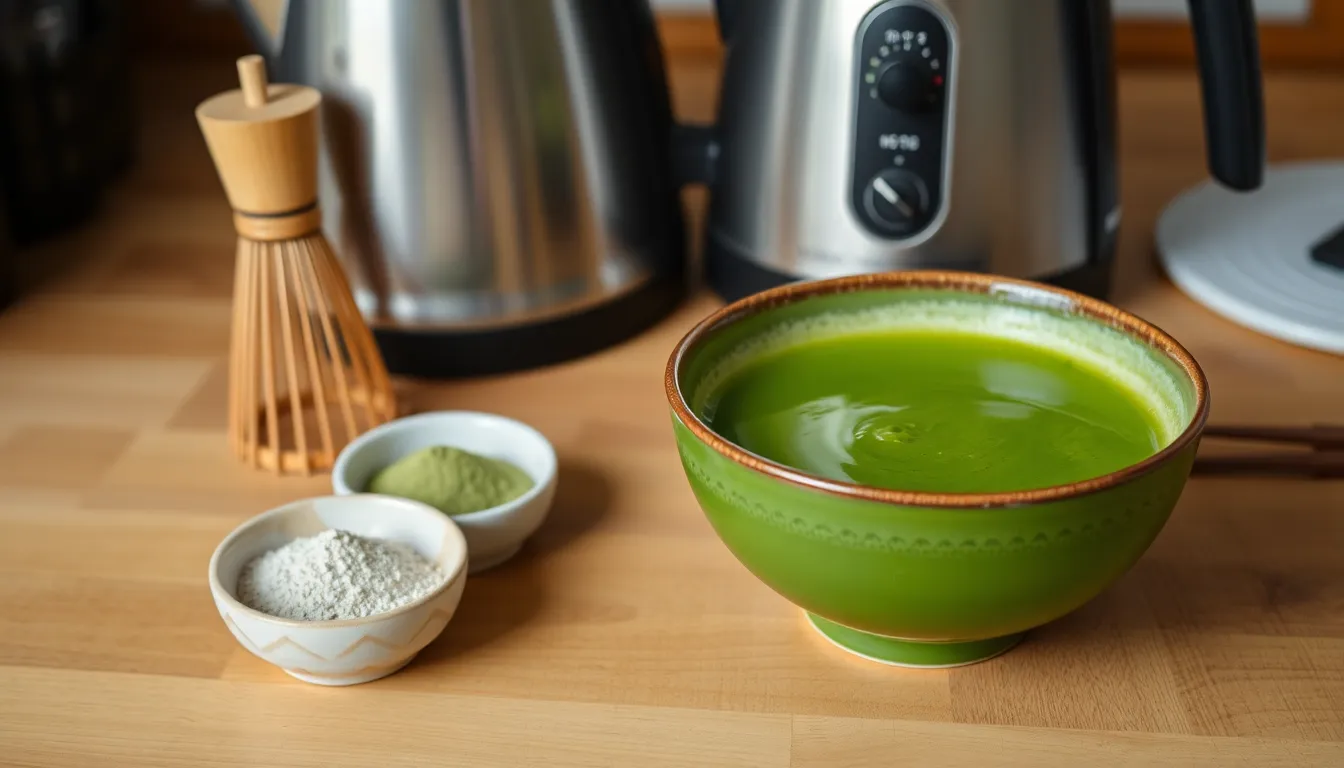
Even experienced bakers encounter challenges when working with matcha’s delicate nature. We’ve compiled the most frequent issues and their answers to help you achieve perfect matcha results every time.
Bitterness Problems
Water temperature plays a crucial role in matcha preparation. When we use water above 176°F (80°C) the delicate compounds in matcha break down and create harsh bitter flavors. The optimal temperature varies by matcha grade but typically ranges between 160-175°F for most culinary applications.
We recommend investing in a thermometer or electric kettle with temperature control to maintain consistency. For ceremonial grade matcha the temperature should stay closer to 160°F while culinary grade can handle slightly higher temperatures up to 175°F.
Clumping Issues
Matcha powder naturally forms clumps due to its fine texture and static charge. We always sift our matcha through a fine mesh strainer before incorporating it into recipes. This simple step prevents lumpy textures in finished desserts and drinks.
Traditional whisking technique also prevents clumping when preparing matcha tea or incorporating it into batters. We use a bamboo whisk (chasen) in “W” or “M” motions rather than circular stirring. This method breaks up clumps while incorporating air for better texture.
Lack of Froth Formation
Quality matters significantly when creating frothy matcha drinks. Low quality matcha lacks the fine particle size and proper processing needed for froth development. We recommend using ceremonial grade matcha for drinks requiring froth.
Whisking technique determines froth success more than any other factor. We whisk briskly with quick wrist movements rather than slow stirring motions. The bamboo whisk creates the ideal texture that modern tools cannot replicate for traditional matcha preparation.
Oxidation and Color Loss
Matcha loses its vibrant green color and delicate flavor when exposed to light and air. We store our matcha in airtight containers away from direct sunlight to prevent oxidation. Refrigerated storage extends freshness but requires proper sealing to prevent moisture absorption.
| Storage Method | Duration | Temperature | Container Type |
|---|---|---|---|
| Room Temperature | 2-3 months | 68-72°F | Airtight tin or jar |
| Refrigerated | 6-12 months | 35-40°F | Sealed container |
| Frozen | 12-24 months | 0°F | Vacuum sealed |
Opening matcha containers briefly for use doesn’t cause immediate oxidation. But we minimize exposure time and reseal containers quickly after measuring portions for recipes.
Temperature Sensitivity in Baking
Matcha’s chlorophyll content makes it sensitive to high baking temperatures. We adjust oven temperatures down by 25°F when baking matcha desserts to preserve color and prevent bitter flavors from developing. This adjustment works particularly well for cookies and cakes.
Lower temperatures require longer baking times but produce superior results. We test doneness with toothpicks rather than relying solely on time since matcha batters may appear different from standard recipes.
Flavor Enhancement Answers
Pairing matcha with complementary flavors helps balance any residual bitterness. We combine matcha with white chocolate vanilla or sweet red bean paste to create harmonious flavor profiles. Ginger and mint additions aid digestion while adding refreshing notes to matcha recipes.
Sugar adjustments may be necessary when working with different matcha grades. Culinary grade matcha often requires additional sweetening compared to ceremonial grade due to its more robust flavor profile.
Conclusion
We’ve explored matcha’s incredible versatility through drinks desserts and even savory dishes that showcase this remarkable green tea powder’s potential. From traditional Japanese sweets to modern fusion creations every recipe demonstrates how matcha transforms ordinary ingredients into extraordinary culinary experiences.
The journey from understanding ceremonial versus culinary grades to mastering proper whisking techniques equips you with everything needed for matcha success. Whether you’re crafting your first matcha latte or attempting delicate macarons these recipes offer endless opportunities to experiment and discover new flavor combinations.
Armed with the right tools storage knowledge and troubleshooting tips you’re ready to embrace matcha’s unique umami profile in your own kitchen. We encourage you to start with simpler recipes and gradually work toward more complex creations as your confidence with this vibrant ingredient grows.
Frequently Asked Questions
What is matcha and how is it different from regular green tea?
Matcha is a finely ground powder made from specially grown green tea leaves called tencha. Unlike regular green tea, matcha leaves are shade-grown to boost chlorophyll content, then stone-ground to preserve delicate flavors and nutrients. When you drink matcha, you consume the entire leaf, providing more antioxidants and a unique umami flavor profile.
What’s the difference between ceremonial grade and culinary grade matcha?
Ceremonial grade matcha is the highest quality, perfect for traditional tea ceremonies and drinking straight. It has a vibrant green color and smooth, sweet taste. Culinary grade matcha is specifically designed for cooking and baking, with a stronger flavor that holds up well in recipes while being more affordable for frequent use.
How should I store matcha powder to maintain its quality?
Store matcha in an airtight container away from light, heat, and moisture. At room temperature, it lasts 2-3 months. Refrigerated matcha stays fresh for 6-12 months, while frozen matcha can last up to 2 years. Always let refrigerated or frozen matcha reach room temperature before opening to prevent condensation.
Why does my matcha taste bitter and how can I fix it?
Matcha bitterness usually results from water that’s too hot (over 175°F) or low-quality powder. Use water between 160-175°F and whisk properly to create froth. Balance natural bitterness by pairing with sweet ingredients like white chocolate, vanilla, or honey. High-quality matcha will have less bitterness naturally.
What equipment do I need to prepare matcha properly?
Essential tools include a chasen (bamboo whisk) for proper froth, a chawan (matcha bowl) for whisking, and a chashaku (matcha spoon) for measuring. A fine-mesh sifter eliminates clumps, and an electric kettle ensures precise water temperature. While modern alternatives exist, traditional tools create superior texture and flavor.
Can I use matcha in savory dishes?
Absolutely! Matcha’s earthy umami notes enhance savory cooking. Create matcha salt for seasoning grilled fish and vegetables, make matcha-infused noodles, or prepare matcha tempura batter for crispy coatings. Its versatility extends beyond sweets, adding depth and complexity to both Asian and Western savory dishes.
How do I prevent matcha from clumping in recipes?
Always sift matcha powder through a fine-mesh strainer before use. This removes clumps and ensures smooth integration into batters and liquids. When making drinks, add a small amount of liquid first to create a paste, then gradually add more liquid while whisking continuously to prevent lumps.
What are the health benefits of matcha?
Matcha contains exceptional levels of antioxidants, particularly catechins, which support overall health. It provides a gentle caffeine boost with L-theanine, promoting calm alertness without jitters. The shade-growing process concentrates chlorophyll and nutrients, making matcha a more potent source of beneficial compounds than regular green tea.
How can I enhance matcha flavor in baking?
Pair matcha with complementary flavors like white chocolate, vanilla, or citrus to balance its earthiness. Use enough matcha powder to achieve desired color and taste—typically 1-2 tablespoons per cup of flour. Slightly reduce oven temperature to prevent burning, and consider adding a pinch of salt to enhance the umami notes.
Can I make matcha desserts ahead of time?
Yes! Many matcha desserts improve with time. Prepare matcha paste and simple syrup in advance for convenience. Cookie dough can be made ahead and refrigerated or frozen. Matcha buttercream frosting develops better flavor after resting. Most matcha desserts can be stored covered for 2-3 days at room temperature or longer when refrigerated.




